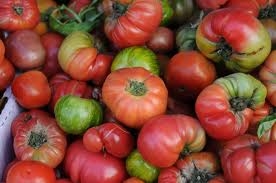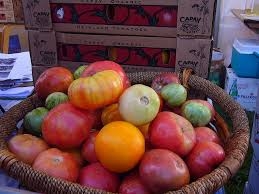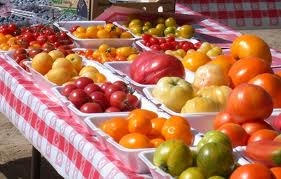Whether or not you have started your tomato seeds, have tomato plants on order or already have plants in the ground, here is some great locally-sourced tomato information. For the past four years, the Sunrise Garden Research Project – spearheaded by Master Gardeners Carolyn Lynch and Laurie Morrow – has been observing the growth, health and productive qualities of quite a number of different tomato plants. As part of this research, they have offered some of these plants out to Master Gardeners who are willing to plant them in their backyard gardens and report back on these same qualities. Here are some of the “fruits” of this long term research project and some “picks” that you might consider for your gardening and eating pleasure.
In 2012, 16 different tomatoes were trialed. Four were small fruited types, three cherries and Juliet, a grape tomato. Of the larger-fruited types, four were extra-early varieties reputed to ripen fruit in 60 or fewer days from transplant: Stupice and Siletz, both open-pollinated and said to ripen well in cold weather, the popular hybrid Early Girl, and the compact hybrid Bush Early Girl. The rest were relatively early at 70 to 75 days plus one at 80 days. Jetsetter, Whopper, Celebrity and Better Boy are hybrids bred to resist various plant diseases and to produce large, flavorful fruit. The remaining four were open-pollinated heirlooms: Azoychka and Paul Robeson -- Siberian varieties in fun colors (yellow and ‘black', really more a chocolate brown), and the red varieties Sioux and Box Car Willie.
In 2013, there were 13 trial varieties. Early Girl was included again and the rest were a mix of open-pollinated and hybrid varieties including large-fruited heirlooms, several heat-resistant types, a couple of paste tomatoes, and again, a few in fun colors.
Plants were distributed and planted the first week in May. In addition to the Sunrise Garden, the trial group included 12 or 13 active participants. About half were in West Bishop, two in Big Pine, and one each on Dixon Lane, Wilkerson, and Paradise. Sunrise was the only downtown garden. It was noted that most of the plants had fruit to ready to pick before, rather than after their "days to harvest" date. One was 3 weeks early! The surprising exception was Early Girl – not so early, but very productive later.
NOTES ON THE VARIETIES
These observations are based on the plants grown at Sunrise, with additional input from home growers as noted.
OP = open-pollinated; HY= hybrid
STUPICE (OP) The earliest variety in our trial. Small fruit (average 1.3 inch diameter) were clean, uniform, attractive and pleasantly juicy. Not a lot of flavor, but a nice acid component without being overly tart. The residents at Sunrise seemed to love them. Medium-size plants suffered in hot weather but rebounded late in the season.
EARLY GIRL (HY) Each large, vigorous plant produced 30 pounds of 2-inch fruit. Flavor was clean, sweet, and bright; fruit were attractive with little cracking or rot. Plants produced especially well early and late in the season and were still growing vigorously and flowering when they froze in October.
BUSH EARLY GIRL (HY) The biggest dud of the trial. Compact plants were very productive for their size but fruit was extremely slow to ripen and didn't look or taste good when it did. Plants quit growing and producing in midsummer.
SILETZ (OP) Another disappointment. This was touted as a good-tasting, relatively large, very early variety and it did produce 10 days earlier than Early Girl. It wasn't worth it. Production was good but most fruit were cracked and/or misshapen and flavor was nothing special.
JETSETTER (HY) Three days later than Early Girl, fruit averaged almost 4 oz. (about 30% larger). Production was significantly lower but still decent at 20 pounds per plant. Juicy fruit had good flavor for a hybrid, winning a taste test against several heirlooms (“sweet, complex”); however, one home grower called it “seedy and flavorless.” There was some cracking and blossom end rot early in the season. Plants were large and healthy.
PARK'S WHOPPER CR IMPROVED (HY) Just a little bit earlier, larger (4.1 oz) and more productive (21 pounds per plant) than Jetsetter, with similarly good flavor. Fruit had very little cracking or blossom end rot. Plants were very large and healthy. Not a standout in any one category, but a really good all-around tomato.
CELEBRITY (HY) Semi-determinate plants were productive but fruit suffered cracking and blossom end rot throughout the season. Flavor was fair to good. A disappointing showing for an award-winning variety.
AZOYCHKA (OP) Pretty, bright yellow fruit averaging almost 4 oz were somewhat susceptible to cracking and blossom end rot. Fruit had smooth texture and medium-sweet, citrusy flavor. Plants were large, robust and moderately productive (15 pounds per plant).
PAUL ROBESON (OP) Chocolate-colored fruit averaged 5 oz and got high scores from the Sunrise tasting panel (“earthy,” “smoky,” “like cabernet!”) but flavor wasn't universally loved by home growers. Fruit suffered some cracking, blossom end rot and cat-facing. Plants did well early in the season but stopped growing and lost leaves in midsummer heat, then rebounded strongly in September. Moderate production of 16 pounds per plant.
SIOUX (OP) The star of this year's trials, one Sioux plant produced 40 pounds of 3-inch fruit with luscious texture and rich tomato flavor, despite being the latest to harvest at 89 days. Some cracking and blossom end rot occurred throughout the season. The extremely vigorous plant had grown far above its trellis and was heading for the sky, flowering and loaded with large green fruit, when it froze. (Note: our second “Sioux” turned out to be something else. After some investigation we concluded that this was probably a random occurrence, maybe a stray seed, and that growers should not expect a similar surprise.) Home growers had mixed but mostly positive results.
BETTER BOY (HY) Large fruit (4.6 oz average) with good flavor, some cracking in midsummer. Production was fair at 18 pounds per plant. This widely grown variety has not shown us why growers should choose it over other red tomatoes that are earlier, more disease-resistant, and/or better tasting.
BOX CAR WILLIE (OP) Production was disappointing at 11 pounds per plant but the 4-oz fruit offered all the deep, rich, “real tomato” flavor our tasting panel craved. Fruit had some cracking and cat-facing. Box Car Willie did better in some (but not all) home gardens than it did at Sunrise.
SUN GOLD (HY) Orange fruit were beautiful but highly susceptible to cracking. Flavor was sweet and complex, a hit with almost everyone. Plants were gigantic and healthy, still pumping out fruit the day before they froze.
SUPER SWEET 100 (HY) Attractive, crack-resistant fruit had good, sweet flavor. Large, healthy plants bore well all season.
GARDENER'S DELIGHT (OP) Fruit had good flavor, not as sweet as the other cherries, but size was quite variable, becoming smaller as the season progressed. Plants began to decline in midsummer, losing leaves and with little new growth or fruit production. Generally disappointing.
JULIET (HY) Attractive, clean fruit had meaty texture and pleasant, not-too-sweet flavor. Fruit had a tendency to fall from the plant when ripe. Plant growth and production slowed markedly from midsummer on.
CONTAINER-GROWN TOMATOES
The two plants grown in 5-gallon containers were far less productive than the same varieties grown in ground beds. We harvested eight 3-oz. fruit from the Siletz and 24 averaging slightly over an ounce from the Bush Early Girl. The cherry tomatoes in larger (15 to 30-gallon) containers did very well, growing and producing abundantly until frost. One home gardener had good results growing the semi-determinate Celebrity in a half whiskey barrel. Plants grown in 5-gallon pots in the Lee Vining community greenhouse produced totals from 12 to 37 medium-size fruit per plant. This grower commented that plants seemed crowded and less productive by midsummer and plans to try using larger containers next year. We conclude that gardeners who don't have space to grow tomatoes in the ground can get good results using containers IF the containers are big enough, and the bigger the better. Container-grown plants need extra attention to ensure they are getting adequate water and will probably benefit from more frequent fertilization.
For the 2013 trial, information was collated by Farm Advisor Dustin Blakey. He notes, “When I look at the data, nothing really stands out as stellar, but Sioux, Cherokee Chocolate, and Early Girl were probably the most dependable and useable. Ball's Beefsteak seemed to have high-quality fruit. There were also a few glitches and problems. There was some question about the San Marzano really being that. And, there was lots of blossom end rot reported on San Marzano and a fair amount on Early Girl. Finally, there was huge variability in Parks Whopper in terms of yield, so another try with it is indicated.”
REALITY CHECK
Seed packets and catalogs make various claims about the results growers should expect. We compared the predicted days from transplant to harvest and the predicted fruit size with the results we got; most varieties did not achieve the promised numbers. There was no real pattern; additional days to harvest ranged from 23 for Early Girl (still respectably early at 68 days) down to earlier than promised for two varieties (Box Car Willie came in more than a week earlier). Sioux came in at 95% of the predicted average weight while Siletz, Box Car Willie and Stupice brought up the rear, at 26%, 27% and 28% respectively. But the numbers in between are all over the place.
The lesson to take here is that results may vary. Days to harvest in Eastern Sierra gardens will likely be longer than predicted and fruit size will usually be smaller, but the estimates can still be useful tools for gardeners to employ when comparing varieties.
RECOMMENDATIONS
After four seasons of trials, we have identified several tomatoes we feel we can recommend to Eastern Sierra growers based on their productivity, plant vigor, and flavor. Earliness is an important factor for local growers; all of these varieties bear in plenty of time for a large harvest but some are recommended in large part for their earliness.
Top Picks
EARLY GIRL: Excellent production of medium-size tomatoes, starting early and continuing all season on vigorous, disease-resistant plants. Flavor is acceptable to very good. Early Girl's popularity is well-deserved.
PARK'S WHOPPER CR IMPROVED: Early production, large, tasty, almost crack-free fruit and disease-resistant plants make Whopper a winner.
SIOUX: Late to produce, but superb flavor and abundant production make Sioux worth the wait.
SUN GOLD: Too much cracking, but so what? You may eat most of them (and there will be a lot) right in the garden. For lovers of sweet cherry tomatoes, Sun Gold is candy.
Worth A Try
STUPICE: Won't win a prize for flavor, but attractive, juicy fruit comes in 2 weeks before Early Girl and keeps coming through September.
JETSETTER: Edged out in our trial by Whopper, it's another large, early, disease-resistant tomato with good flavor.
AZOYCHKA, PAUL ROBESON: These two offer early production, beautiful colors and distinctive flavors. Productivity varies and fruit may be oddly shaped.
BETTER BOY: Moderate but reliable production of good, not great, tomatoes. Some disease-resistance.
BOX CAR WILLIE: Exceptional flavor makes this one worth growing.
SUPER SWEET 100: Another really good cherry for those who like them sweet. Crack-resistant and highly productive.
JULIET: Grape-type fruit is very attractive; meaty texture makes Juliet great for salsa, cooking and drying.
Of Note
Biggest tomatoes by size and weight: Ball's Beefsteak, German Johnson, Gregoris Altai, Virginia Sweets and Cherokee Chocolate.
Best Producers: Bloody Butcher, San Marzano and Early Girl
Earliest Fruit: Bloody Butcher, Matina, Jet Setter (Latest to fruit – Box Car Willie)
Beauty Contest Winners: Arkansas Traveler, Pruden's Purple, Cherokee Chocolate, and Virginia Sweets.
Blossom End Rot Problems: Sioux, Supersauce, Early Girl, Bella Rosa, Ball's Beefsteak, Better Boy and Box Car Willie.
Best Flavor: Sioux, Pruden's Purple, Box Car Willie, Jet Setter, Virginia Sweets


